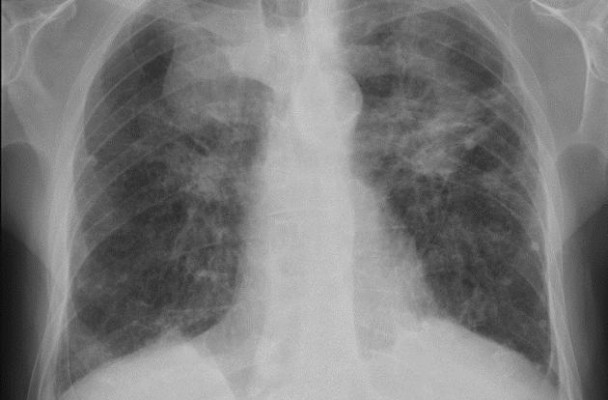Two Noteworthy Stories and Media Roundup from Last Week About Black Lung Resurgence Article from JAMA

A lung x-ray of a miner with Progressive Massive Fibrosis (PMF), the most severe form of black lung.
After last week’s important publication in JAMA discussing NIOSH’s unprecedented finding of 416 coal miners with severe black lung—the largest single cluster of black lung ever identified—there was a flurry of media attention to the resurgence of black lung.
In addition to NPR’s story that coincided with the article’s publication, original stories appeared in other media outlets including Smithsonian, The Lexington Herald-Leader, Ars Technica, WCYB, MedPage Today, WDTV, Salon, Digital Journal, (not to mention the AP story that received national coverage). I’m partial to the Herald-Leader story but I’ll try to keep a lid on the home cooking.
There are two stories in particular that should not be overlooked.
1. Radio Piece by Benny Becker Profiling Two Miners
Benny Becker of WMMT and the Ohio Valley ReSource, has a radio piece “Living With Black Lung: Coal Miners Caught In A Surging Epidemic” that brings the human side of the story to the fore. He interviews 2 of the 416 miners. One story shows the system working: Jerry Helton obtained his benefits promptly and got a lung transplant in 2016 that has addressed his black lung. But the other miner, Edward Brown, is still seeking his benefits and is suffering the hardship of black lung, both physically and mentally.
Becker’s story is a reminder that severe black lung can be addressed (albeit at a cost of millions of dollars). But there are many miners like Mr. Brown who need immediate assistance.
2. BNA Story on Black Lung Clinics Funding
NIOSH’s finding that was published in JAMA would not have been possible without
BNA News’s Occupational Safety & Health Reporter raised an important issue: given the importance of black lung clinics, are they being sufficiently funded?
The article discusses the HRSA grants that provide essential funds to black lung clinics and bipartisan efforts by members of Congress such as Morgan Griffith (R-VA) and Bobby Scott (D-VA) to increase the annual clinic funding from around $6.7 million per year to the statutory authorization of $10 million per year.
The article explained what shortage of funding means on the ground:
The funding level means the three clinics Stone Mountain Health Services operates in southwestern Virginia that NIOSH studied must use decades-old medical equipment, Ron Carson, director of the clinic’s black lung program, told Bloomberg Environment. He said area veterinarians have more modern health-care facilities.
Miners suffer through both unnecessary health risks—being exposed to higher radiation levels than necessary through 1970s-era X-ray machines—and needless delays when printed readings must be mailed elsewhere for analysis, Carson said.
Whether black lung clinics will receive the funding that they need and are allowed under law is uncertain due to the complicated budget process.
For those who are looking for a proactive action that they can take to help miners like those covered in Becker’s radio piece, black lung clinics funding is an important short-term goal.